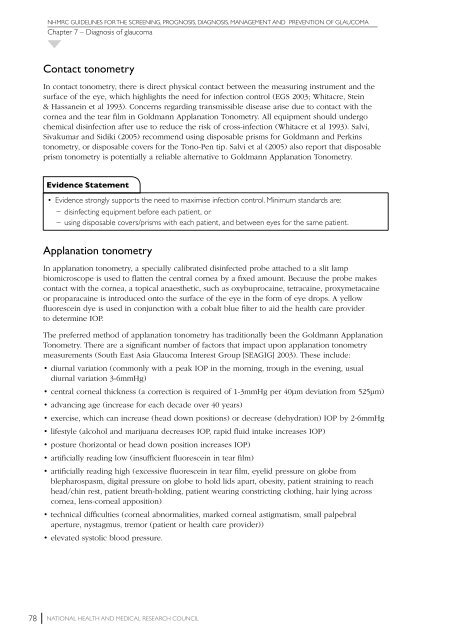NHMRC Glaucoma Guidelines - ANZGIG
NHMRC Glaucoma Guidelines - ANZGIG
NHMRC Glaucoma Guidelines - ANZGIG
You also want an ePaper? Increase the reach of your titles
YUMPU automatically turns print PDFs into web optimized ePapers that Google loves.
<strong>NHMRC</strong> GUIDELINES FOR THE SCREENING, PROGNOSIS, DIAGNOSIS, MANAGEMENT AND PREVENTION OF GLAUCOMA<br />
Chapter 7 – Diagnosis of glaucoma<br />
Contact tonometry<br />
In contact tonometry, there is direct physical contact between the measuring instrument and the<br />
surface of the eye, which highlights the need for infection control (EGS 2003; Whitacre, Stein<br />
& Hassanein et al 1993). Concerns regarding transmissible disease arise due to contact with the<br />
cornea and the tear film in Goldmann Applanation Tonometry. All equipment should undergo<br />
chemical disinfection after use to reduce the risk of cross-infection (Whitacre et al 1993). Salvi,<br />
Sivakumar and Sidiki (2005) recommend using disposable prisms for Goldmann and Perkins<br />
tonometry, or disposable covers for the Tono-Pen tip. Salvi et al (2005) also report that disposable<br />
prism tonometry is potentially a reliable alternative to Goldmann Applanation Tonometry.<br />
Evidence Statement<br />
• Evidence strongly supports the need to maximise infection control. Minimum standards are:<br />
−−disinfecting equipment before each patient, or<br />
−−using disposable covers/prisms with each patient, and between eyes for the same patient.<br />
Applanation tonometry<br />
In applanation tonometry, a specially calibrated disinfected probe attached to a slit lamp<br />
biomicroscope is used to flatten the central cornea by a fixed amount. Because the probe makes<br />
contact with the cornea, a topical anaesthetic, such as oxybuprocaine, tetracaine, proxymetacaine<br />
or proparacaine is introduced onto the surface of the eye in the form of eye drops. A yellow<br />
fluorescein dye is used in conjunction with a cobalt blue filter to aid the health care provider<br />
to determine IOP.<br />
The preferred method of applanation tonometry has traditionally been the Goldmann Applanation<br />
Tonometry. There are a significant number of factors that impact upon applanation tonometry<br />
measurements (South East Asia <strong>Glaucoma</strong> Interest Group [SEAGIG] 2003). These include:<br />
• diurnal variation (commonly with a peak IOP in the morning, trough in the evening, usual<br />
diurnal variation 3-6mmHg)<br />
• central corneal thickness (a correction is required of 1-3mmHg per 40μm deviation from 525μm)<br />
• advancing age (increase for each decade over 40 years)<br />
• exercise, which can increase (head down positions) or decrease (dehydration) IOP by 2-6mmHg<br />
• lifestyle (alcohol and marijuana decreases IOP, rapid fluid intake increases IOP)<br />
• posture (horizontal or head down position increases IOP)<br />
• artificially reading low (insufficient fluorescein in tear film)<br />
• artificially reading high (excessive fluorescein in tear film, eyelid pressure on globe from<br />
blepharospasm, digital pressure on globe to hold lids apart, obesity, patient straining to reach<br />
head/chin rest, patient breath-holding, patient wearing constricting clothing, hair lying across<br />
cornea, lens-corneal apposition)<br />
• technical difficulties (corneal abnormalities, marked corneal astigmatism, small palpebral<br />
aperture, nystagmus, tremor (patient or health care provider))<br />
• elevated systolic blood pressure.<br />
78 National Health and Medical Research Council





